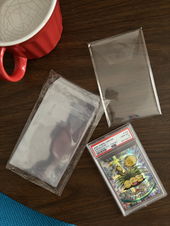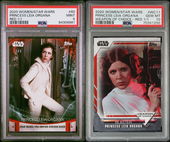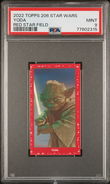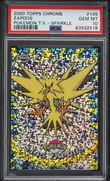
367

367
thunderbidder
Cody James
8
Posts
6
Topics
18
Followers
0
Following
8
Posts
6
Topics
18
Followers
0
Following
Invite Friends & Earn Rewards
Work your way up to exclusive Mantel rewards by inviting your friends.

Mantel Points
367
Bio
I collect mostly non-sports trading cards, with a focus on fictional universes like Pokemon, Star Wars, Disney, and superheroes.
Social Accounts
Happy Fantastic Four opening weekend!


I just saw the movie and loved it! Felt like a simpler Interstellar (not a bad thing) meets the Jetsons.
Here are two 2024 Mr. Fantastic one-of-ones, representing the crossover of two eras of Marvel cards. Upper Deck has had a great run with the Marvel license, defining the genre by bringing the famed 90s sports insert, Precious Metal Gems or PMGs, into the Marvel universe with their 2013 Marvel Metal set. Now Topps is taking over and doing what they do best - making everything chrome.
We have Upper Deck's Marvel Platinum "Golden Treasures" one-of-one, which is essentially a superfractor. Upper Deck is largely known for their creative inserts (e.g. Jambalaya, real metal inserts, clear acetate inserts), while Topps focuses largely on just different color variants of chrome cards. It is interesting to see that Upper Deck may have been shifting towards a more Topps-esque approach, with this set being exclusively chromium cards, if they had retained the Marvel license, even going as far as imitating the superfractor to a tee in one of their last sets.
We also have the Topps Chrome Sapphire "Padparadscha" one-of-one. While 2024 saw the debut of Topps Chrome Marvel with the standard chrome parallels that we often see in sports, they also released a more limited Sapphire sister set with the same art, also common in sports, that has a cracked ice pattern on the various parallels. Replacing a superfractor in this set is the pink padparadscha one-of-one, referencing a rare sapphire variant.
I did enjoy the creativity and diversity of Upper Deck sets - seeing multiple chrome sets per year, as we are now seeing with Star Wars, can be a bit exhausting. But I will always appreciate a debut set, and 2024 being the first year for Marvel under the historic Topps brand makes both 2024 Chrome and 2024 Sapphire sets I'd like to collect.
Who do you think did it better - Upper Deck in their last attempt or Topps in their debut?
Developing Story: Massive Pokemon Scandal - Many "Original" Playtest Cards Likely Printed in 2024






+2
A thread on the most popular Pokemon forum, E4, has just uncovered what could be one of the largest scandals in the industry. Credit to user "pfm" for the in-depth research and discovery. The thread can be found here:
https://www.elitefourum.com/t/many-of-the-pokemon-playtest-cards-were-likely-printed-in-2024/52421
I will try to recap here:
A flood of "playtest" cards, claimed to have been early prototype cards used in the development of the TCG, have surfaced this past year and hit the market. Though some early articles exist showcasing them in the past, they had never been brought to market. That changed dramatically this past year, with many copies coming to auction seemingly every week, and almost always fetching in the thousands of dollars (and the record public sale being $99,000 at Fanatics Collect for a "Beta" Charizard, graded a GCG 8).
While many collectors were concerned with the undisclosed provenance of these cards, most of those concerns were put to rest when CGC started authenticating them, though notably their authentication process was not disclosed. A surprising number of copies also received either Gem Mint 10 or Pristine 10 grades.
The one thing known about the origin of these cards has been that Akabane, often credited as one of the early contributors to the development of the TCG, is involved with their surfacing. CGC has even arranged for sessions where he has signed copies of these playtest cards in the presence of a CGC representative for them to authenticate the autograph. I will note that most people suspect he is the person who has operated under the alias "Pkonno" the past decade or so, releasing after-market copies of the top tier trophy cards that have also flooded the market the past years, and regularly sell in the 5 and 6 figures (I have posted about this astonishingly overlooked fact on Mantel in the past).
The shocking discovery being discussed now is that high resolution scans with specific color settings seem to reveal metadata from the printer used to print some of these cards, specifically a version of the "Beta" playtest cards. Decoding these signatures seems to reveal a print date in the year 2024, implying that these may have been very recently printed rather than originating in or before 1996, as originally thought and advertised.
While the story is just beginning to unfold, this does seem like quite damning evidence for the Pokemon influencers who have been heavily involved in bringing these to market, possibly Akabane himself, and CGC, who have authenticated the vast majority of copies. Collectors are due an explanation, and compensation if it turns out how it looks, from the parties involved. The auction platform ALT, who has sold a number of these cards, has already issued a statement that they are aware of the problem and that CGC has assured them that they are looking into it, although CGC has not yet made any public statements at the time of this article.
My early takeaway is that lack of transparency is always a red flag with collectibles, and provenance should be given much more respect in the Pokemon space, like it is given in most mature collectibles spaces. We will see how it plays out - hopefully those that are affected are compensated appropriately, and the hobby can use this as a lesson to grow and mature.
Warning: Perfect Fit Sleeves Damage Slabs




The first thing I have always done when I receive a slab is to sleeve it before it can get scratched. Over the years, I have also noticed an abundance of vertical scratches along PSA slabs. Now I see that they are related.
I just received back a PSA order and immediately got to sleeving my slabs into perfect fit sleeves. When I popped one back up, I noticed the familiar thin vertical scratches, but this time, I knew I had just put in a completely clear and clean slab. I went back and checked all of the slabs I had just sleeved, and sure enough, every single one had immediately been afflicted with the vertical scratches to varying degrees.
I attempted to buff them out with a natural polish, but had no success. I have read in forums about removing scratches with plastic polishes, but I don’t love the idea of putting abrasives that close to my cards.
After doing some research, I found that this is actually a pretty common phenomenon. See here for threads discussing the topic:
https://www.blowoutforums.com/showthread.php?t=1522481
https://www.elitefourum.com/t/do-graded-card-sleeves-scratch-up-the-case/40138/15
I must say that I am disappointed that even the new PSA cases scratch this easily - I gently slid the cards in and out of the sleeves, even being careful not to apply pressure to the surface. However, it seems that perfect fit sleeves are not at all suitable to protect slabs and actually do more harm than good. Looking through my collection, I see that this occurred with multiple brands of perfect fit sleeves rather than being a problem with one product in particular. This realization makes the appeal of alternative companies that focus on slab quality like Rare Edition - who use scratch-proof Gorilla Glass for their slabs - much more appealing.
My entire collection is sleeved, but I will be removing them from every card. I am looking for suggestions on alternative ways to protect and store large quantities of slabs. GradedGuard offer a nice product, but they are quite bulky and leave one side exposed. Slabmags offer protection on both sides but are also quite bulky and obscure the card a bit.
Would love to hear what other people use, and if people do have suggestions on safely removing scratches. Thanks!
Matching 1/1s /// Women of Star Wars: Princess Leia Organa


Here is a cool duo I picked up separately. Both are from an awesome 2020 Topps set - Women of Star Wars.
The first is the red 1/1 base parallel. The second is from the only character-driven parallel in the set - Weapon of Choice - here featuring Leia's iconic "Drearian Defense Conglomerate" blaster pistol.
I will admit that I didn't know her pistol was attributed to a certain make until reading the back of this card. One thing I love about the expansiveness of the Star Wars universe is how many different creative people and groups have contributed to the lore from different places over the years. The Drearian Defense Conglomerate, a weapons manufacturer specializing in weapons for nobles like Leia, was first coined in the 1992 rulebook for "Star Wars: The Roleplaying Game, Second Edition," and later became canon when mentioned again in a 2015 "Ultimate Star Wars" reference book. Now it is prominently featured on an official Topps trading card!
I appreciate that Topps made a set highlighting the great female characters in the universe, especially given how toxic and misogynistic much of the fan base can be (at least online). I really hope that changes with the younger generations and Disney continues to write strong women into their stories.












